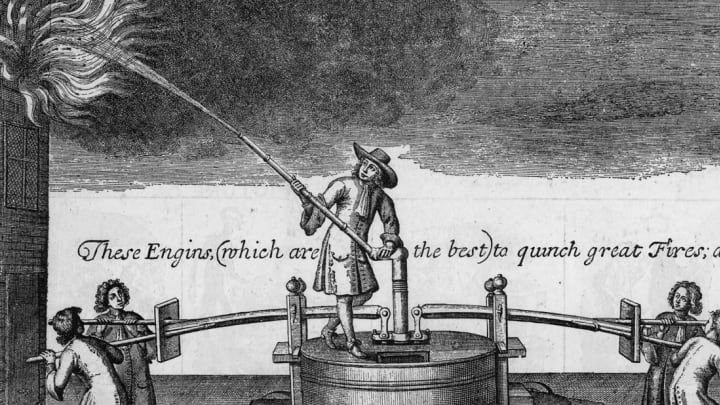Shortly after midnight on September 2, 1666, a fire broke out in the basement of a bakery in the area of Pudding Lane in central London. With the timbers of the city’s buildings all bone dry thanks to a summer-long drought, the fire quickly spread, so that by the time it burned itself out three days later on September 5, the Great Fire of London had destroyed more than 13,000 houses, three city gates, the entire Royal Exchange building, and almost 90 churches—including St. Paul’s Cathedral—while an estimated 80,000 of the city’s inhabitants had been left homeless. Surprisingly, there are believed to have only been a handful of fatalities as a direct result of the fire. But even more surprisingly, this wasn’t the first time London had been burned to the ground.
Throughout history, the city of London has been all but destroyed by fire on more than a dozen different occasions—usually accidentally, sometimes deliberately. As William Fitzstephen, a 12th century cleric and writer, once put it, “the only plagues of London are the immoderate drinking of fools, and the frequency of fires.”
1. BOUDICEA GETS HER REVENGE // CIRCA 60 CE
After the death of her husband Prasutagus in the mid-1st century CE, lands that should rightfully have passed to the ancient British queen Boudicea and her daughters were instead claimed by the invading Roman Empire. Before then, Boadicea’s tribe, the Iceni, had been allied with the Romans, but the entire affair soured that relationship.
Enraged, Boudicea sacked the Roman city at modern Colchester and marched her army on towards London—or rather, to the newly founded Roman settlement of Londinium—and burned it to the ground. So total was Boadicea’s destruction of the city that archaeologists working the capital today can still identify a noticeable thin layer of red-brown oxidized ash on the site occupying the original settlement, and Roman coins melted together by the extreme heat have even been found along the muddy banks of the Thames.
2. THE HADRIANIC FIRE // c.122 CE
After Boadicea’s rampage, Londinium was speedily rebuilt and flourished for the next 60 years—until, according to archaeological evidence, it burned to the ground a second time sometime after the Roman Emperor Hadrian visited Britain in the early 120s. Known as the Hadrianic Fire, precisely what caused this second destruction of the city remains a mystery, and debate continues as to whether it was accidental or a deliberate act of war.
3. ANGLO-SAXON ENGLAND // 1087 CE
According to Peter Ackroyd’s London: The Biography, devastating fires broke out in London in 675 CE—when the first wooden cathedral dedicated to St. Paul was destroyed—and in 764, 798, 852, 893, 961, 982, 1077, and 1087, when “the greater part of the city” was destroyed. According to records, St. Paul’s Cathedral was destroyed again in 961 and a third time in the 1087 fire.
4. THE PENTECOST FIRE // CIRCA 1135
On Pentecost—Sunday, May 26—1135 (or thereabouts), another devastating fire broke out close to London Bridge, possibly, according to some reports, in the home of the Sheriff of London, Gilbert Becket (father of Archbishop of Canterbury Thomas Becket). One chronicler said that St. Paul’s was destroyed in this fire, but most historians say that it survived. Much of the rest of the city fared less well: The fire all but destroyed the original wooden-frame London Bridge, as well as homes and properties across a 1.5-mile stretch of land along the banks of the river.
5. THE GREAT FIRE OF SOUTHWARK // 1212
On July 10, 1212, a fire broke out in the borough of Southwark on the southern end of London Bridge. The bridge itself had only recently been rebuilt—but this time, the bridge had been built from stone, and its main structure withstood the flames. The wooden shops and houses that King John had permitted to be built along the length of the bridge, however, fared less well. Strong winds pushed the fire northwards along the bridge, trapping dozens of people either trying to escape or trying to extinguish the flames. According to one 17th century account:
An exceeding great multitude of people passing the Bridge, either to extinguish or quench it, or else to gaze at and behold it, suddenly the north part, by blowing of the south wind, was also set on fire, and the people which were even now passing the Bridge, perceiving the same, would have returned, but were stopped by the fire.
As many as 3000 people are said to have lost their lives in the so-called Great Fire of 1212, but other accounts suggest that that number may be exaggerated. Whatever the true scale of the disaster, prior to 1666 this was the worst fire London had yet faced.
6. A HAPPY ACCIDENT // 1633
A relatively small fire broke out, again on London Bridge, in 1633, destroying 42 buildings and spreading along the bank of the river as far as the end of Thames Street, roughly half a mile away. Houses and properties destroyed in the 1633 blaze took a long time to be replaced, and many were still awaiting reconstruction when the Great Fire broke out in 1666. But fortuitously, it’s thought that this stretch of undeveloped land acted as a firebreak, and prevented London Bridge from being destroyed all over again 33 years later.
7. THE RATCLIFFE FIRE // 1794
On the afternoon of July 23, 1794, an unattended kettle of pitch boiled over in a barge yard in Ratcliffe in north central London, and the resulting fire eventually spread to a nearby barge filled with saltpeter, one of the raw ingredients of gunpowder. The immense explosion scattered burning debris across a vast swathe of the city, destroying more than 450 buildings—mainly industrial warehouses and timber yards—and leaving 1400 Londoners homeless. The so-called Ratcliffe Fire of 1794 saw the worst destruction of the city of London between 1666 and the Blitz of the Second World War.
